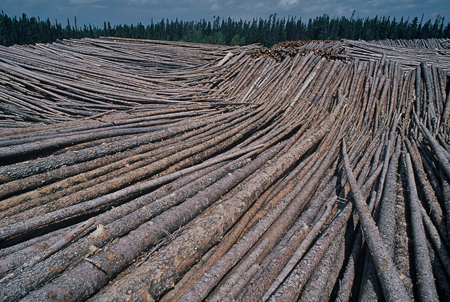
Smokestacks and tailpipes aren't the only major source of emissions.
Credit: Wikimedia user: Dori
Although most people envision smokestacks and tailpipe exhaust when thinking about greenhouse gas emissions, deforestation is an often underreported component of our human contribution to climate change. Most estimates place carbon emissions from deforestation at somewhere between 12-25% of all human emissions at the global scale.
A recent New York Times blog highlighted the growing field of carbon storage mapping, in this instance an interesting new map by the Woods Hole Research Center that focuses on vegetative height throughout the tropics. This type of analysis can provide estimates for carbon density within tropical areas where the majority of stored carbon lies in the vegetation itself.
It also mentioned the importance of boreal forests further north—which actually store more carbon than tropical forests—but this type of analysis (vegetative height) doesn’t work as well due to the fact that much of the boreal’s carbon is below ground in the soils and wetlands. This doesn’t mean that logging has less of an impact in the boreal, however. The soils and wetlands following logging will often either dry out or become permanently altered, thus releasing carbon.

Log pile in Canada's boreal forest.
Credit: Garth Lenz
While this type of research is probably more alluring to climate scientists and policy wonks, the impacts of this growing research field could yield far-ranging benefits to birds and birders.
The purpose of measuring carbon storage and density is primarily to increase incentives to preserve forests from deforestation. This is great for birds for two reasons: 1) preserving more forested areas and wetlands from development will inevitably preserve important bird habitat, and 2) it will help slow climate change, which has already been found to be impacting birds.
Some governments have already started taking this seriously.
To the south, Brazil has taken measures to reduce deforestation in recent years with climate change being cited as one of the primary factors. Recent studies indicate it has already started working.
Up north, Manitoba has committed to a boreal peatlands stewardship strategy to help protect Manitoba’s vast and lush forests and wetlands. These areas are dense with not only carbon, but birds. Some of North America’s most threatened migrants, including the Rusty Blackbird and Olive-sided Flycatcher, breed and thrive in these insect-rich habitats. Ontario and Quebec have both pledged to preserve half of their northern boreal forests, with climate change weighing in as an important factor.
Olive-sided Flycatcher I filmed in Manitoba
These two forests—the Amazon and the Boreal—are some of the most important habitats for migratory birds. The Amazon (and many of the tropical forests in Central America, the Caribbean and other parts of South America) are widely used by migrants during the winter. Many of these birds will subsequently fly up to the boreal to breed during the summer, often stopping along the way to our great benefit.
So the better experts and politicians understand the importance of forests in climate change—and thus the need to preserve them—the better news it is for birds and us birders alike.

